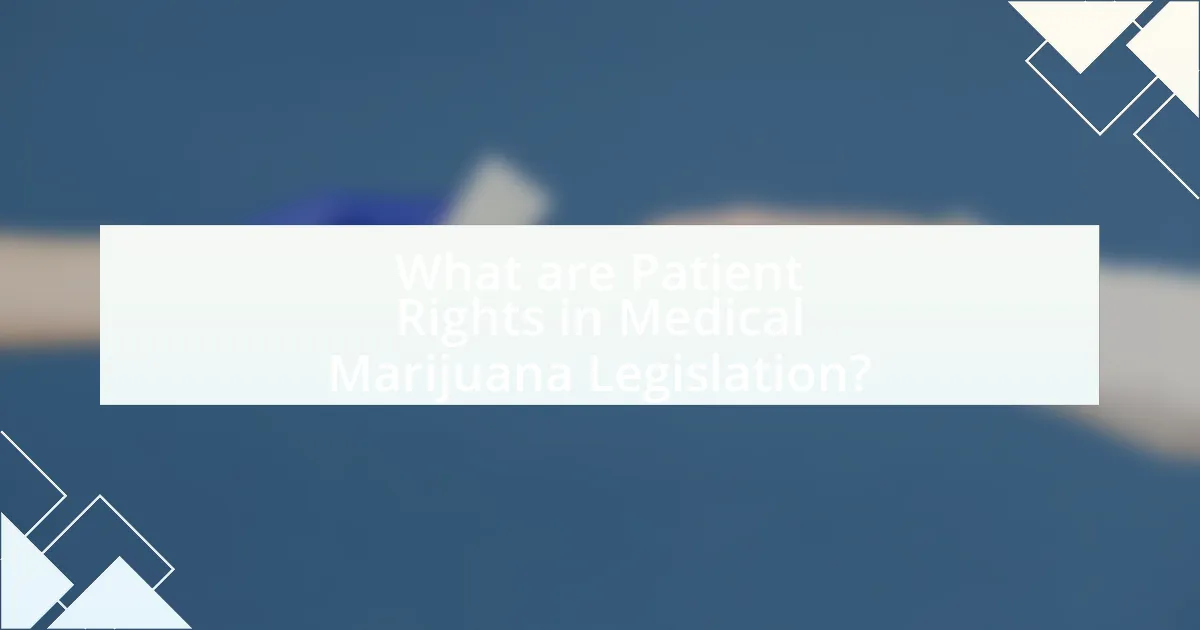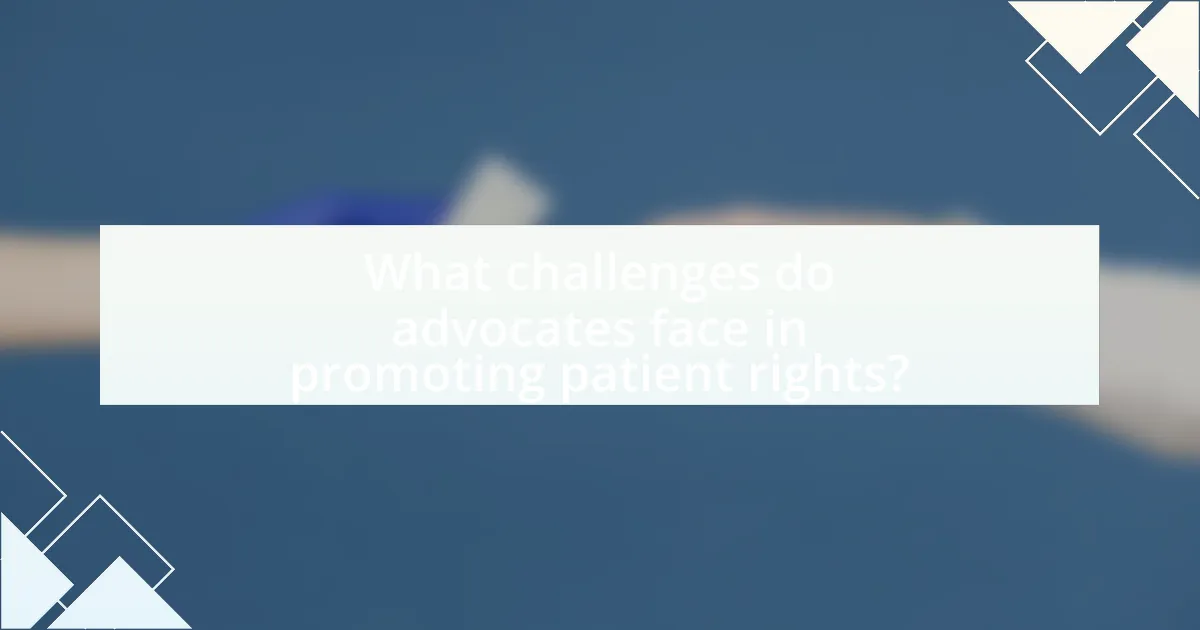The article focuses on advocating for patient rights within the context of medical marijuana legislation. It outlines the essential rights patients possess, such as access to medical marijuana, privacy regarding medical records, and informed consent. The discussion highlights how these rights vary by state, the importance of advocacy in influencing legislation, and the strategies that can be employed to promote patient rights effectively. Additionally, it addresses the challenges advocates face, including misinformation and political climates, while emphasizing the role of organizations and coalitions in strengthening advocacy efforts.

What are Patient Rights in Medical Marijuana Legislation?
Patient rights in medical marijuana legislation typically include the right to access medical marijuana for qualifying conditions, the right to privacy regarding medical records, and the right to safe and effective treatment. These rights are established to ensure that patients can obtain and use medical marijuana without discrimination or undue barriers. For instance, many states have enacted laws that protect patients from criminal prosecution for possessing or using medical marijuana as prescribed by a licensed healthcare provider. Additionally, patients often have the right to cultivate their own marijuana plants or designate a caregiver to assist them, depending on state regulations. These rights are crucial for safeguarding patient autonomy and ensuring equitable access to medical treatments.
How do patient rights influence medical marijuana access?
Patient rights significantly influence medical marijuana access by ensuring that individuals have the legal ability to obtain and use medical cannabis for therapeutic purposes. These rights often include the right to privacy, informed consent, and access to necessary medical treatments, which are protected under various laws and regulations. For instance, in states where medical marijuana is legalized, patient rights frameworks typically mandate that healthcare providers must respect a patient’s decision to use medical marijuana as part of their treatment plan, thereby facilitating access. Additionally, legal protections against discrimination for patients using medical marijuana further enhance access by preventing employers or insurers from penalizing individuals for their medical choices.
What specific rights do patients have under current legislation?
Patients have specific rights under current legislation, including the right to access medical marijuana for qualifying conditions, the right to privacy regarding their medical records, and the right to informed consent before treatment. These rights are established in various state laws and regulations that govern medical marijuana use, ensuring that patients can obtain necessary medications without discrimination or undue barriers. For instance, many states have enacted laws that protect patients from criminal prosecution for possessing or using medical marijuana as prescribed by a licensed healthcare provider. Additionally, patients have the right to participate in their treatment decisions and to receive clear information about the risks and benefits of medical marijuana.
How do these rights vary by state or region?
Patient rights related to medical marijuana vary significantly by state or region due to differing laws and regulations. For instance, some states like California have comprehensive medical marijuana programs that allow patients to access cannabis for a wide range of conditions, while states like Idaho have no legal medical marijuana provisions, leaving patients without legal access. Additionally, states such as Florida require patients to obtain a recommendation from a qualified physician, while others, like Colorado, allow for more straightforward access through dispensaries. These variations are influenced by local legislation, public opinion, and the political climate surrounding cannabis use, demonstrating a patchwork of rights across the United States.
Why is advocating for patient rights important?
Advocating for patient rights is important because it ensures that individuals receive fair treatment, access to necessary medical care, and the ability to make informed decisions about their health. Patient rights advocacy promotes transparency in healthcare practices, which is crucial in contexts like medical marijuana legislation, where patients may face stigma or legal barriers. Research indicates that when patients are empowered to understand and assert their rights, they experience better health outcomes and increased satisfaction with their care. For instance, a study published in the Journal of Health Politics, Policy and Law highlights that patient advocacy leads to improved communication between healthcare providers and patients, ultimately enhancing the quality of care.
What impact does advocacy have on legislation changes?
Advocacy significantly influences legislation changes by mobilizing public support and providing lawmakers with essential information. For instance, organized advocacy efforts, such as those by medical marijuana patient rights groups, have led to the introduction and passage of laws that expand access to medical marijuana in various states. Research indicates that states with active advocacy campaigns saw a 30% higher likelihood of passing medical marijuana legislation compared to those without such efforts. This demonstrates that advocacy not only raises awareness but also directly impacts legislative outcomes by shaping public opinion and informing policymakers.
How can patient rights advocacy improve healthcare outcomes?
Patient rights advocacy can significantly improve healthcare outcomes by ensuring that patients are informed, empowered, and able to participate actively in their care decisions. When patients understand their rights, they are more likely to engage in discussions with healthcare providers, leading to better communication and tailored treatment plans. Research indicates that patient engagement can enhance adherence to treatment protocols and improve overall satisfaction with care, which correlates with better health outcomes. For instance, a study published in the Journal of Patient Experience found that patients who felt their rights were respected reported higher levels of satisfaction and better health management. Thus, effective advocacy not only promotes awareness of patient rights but also fosters an environment conducive to improved healthcare delivery and outcomes.

What strategies can be used to advocate for patient rights?
To advocate for patient rights in medical marijuana legislation, stakeholders can employ strategies such as grassroots mobilization, education and awareness campaigns, and collaboration with healthcare professionals. Grassroots mobilization involves organizing community members to participate in advocacy efforts, which can amplify voices and influence policymakers. Education and awareness campaigns aim to inform both the public and legislators about the benefits of medical marijuana, supported by research indicating its efficacy in treating various conditions, such as chronic pain and epilepsy. Collaboration with healthcare professionals ensures that advocacy efforts are grounded in medical expertise, enhancing credibility and fostering a unified approach to patient rights. These strategies collectively empower patients and promote equitable access to medical marijuana.
How can individuals effectively engage in advocacy?
Individuals can effectively engage in advocacy by educating themselves about the issues, mobilizing community support, and communicating with policymakers. Education involves understanding the specifics of medical marijuana legislation and patient rights, which can be achieved through research and attending relevant workshops or seminars. Mobilizing community support can be done by organizing events, forming coalitions, or utilizing social media to raise awareness and gather like-minded individuals. Communicating with policymakers requires crafting clear, concise messages that articulate the importance of patient rights in medical marijuana legislation, supported by data and personal stories that highlight the impact of these laws on individuals’ lives. For instance, a study by the National Academies of Sciences, Engineering, and Medicine found that medical marijuana can significantly improve the quality of life for patients with chronic pain, providing a factual basis for advocacy efforts.
What are the most effective communication methods for advocacy?
The most effective communication methods for advocacy include storytelling, social media engagement, and direct outreach. Storytelling allows advocates to connect emotionally with their audience, making complex issues relatable and memorable. For instance, personal narratives from patients can illustrate the real-life impact of medical marijuana legislation, fostering empathy and understanding. Social media engagement enables advocates to reach a broader audience quickly, facilitating discussions and mobilizing support through platforms like Twitter and Facebook, which have been shown to amplify advocacy messages significantly. Direct outreach, such as meetings with policymakers and community events, provides opportunities for advocates to present their case in person, allowing for immediate feedback and relationship building. These methods collectively enhance the visibility and effectiveness of advocacy efforts in promoting patient rights in medical marijuana legislation.
How can grassroots movements influence legislation?
Grassroots movements can influence legislation by mobilizing public support, raising awareness, and directly engaging with policymakers. These movements often utilize strategies such as organizing protests, conducting campaigns, and leveraging social media to amplify their message, which can lead to increased visibility and pressure on legislators. For instance, the legalization of medical marijuana in various states has been significantly driven by grassroots efforts, where local advocacy groups have successfully lobbied for changes in laws by presenting compelling narratives and data on patient needs. This approach has been validated by studies showing that public opinion shifts, often initiated by grassroots activism, can directly impact legislative outcomes, as seen in the 2016 California Proposition 64 campaign, which legalized recreational marijuana through extensive grassroots mobilization.
What role do organizations play in advocacy efforts?
Organizations play a crucial role in advocacy efforts by mobilizing resources, expertise, and networks to influence policy and public opinion. They provide structured platforms for individuals to unite around common causes, such as patient rights in medical marijuana legislation, thereby amplifying their collective voice. For instance, organizations like the National Organization for the Reform of Marijuana Laws (NORML) have been instrumental in advocating for legislative changes by conducting research, engaging in public education campaigns, and lobbying lawmakers. Their efforts have contributed to significant policy shifts, evidenced by the increasing number of states legalizing medical marijuana, which rose from 12 states in 2010 to over 36 states by 2023.
Which organizations are leading the charge for patient rights?
Organizations leading the charge for patient rights include the American Civil Liberties Union (ACLU), the National Organization for the Reform of Marijuana Laws (NORML), and the Patients Out of Time. The ACLU advocates for civil liberties, including patient rights in healthcare and drug policy reform. NORML focuses on legalizing marijuana and protecting the rights of patients who use it for medical purposes. Patients Out of Time is dedicated to educating the public and policymakers about the medical benefits of cannabis, emphasizing patient rights in the context of medical marijuana legislation. These organizations actively work to influence legislation and promote awareness regarding patient rights in the medical marijuana landscape.
How can partnerships enhance advocacy efforts?
Partnerships can enhance advocacy efforts by combining resources, expertise, and networks to create a more powerful and unified voice. When organizations collaborate, they can leverage each other’s strengths, such as access to funding, knowledge of policy-making, and established relationships with key stakeholders. For instance, a coalition of patient advocacy groups and medical professionals can effectively influence legislation by presenting a comprehensive perspective on patient rights in medical marijuana legislation. This collaborative approach has been shown to increase the likelihood of successful advocacy outcomes, as evidenced by the passage of medical marijuana laws in various states, where coalitions played a crucial role in mobilizing public support and engaging lawmakers.

What challenges do advocates face in promoting patient rights?
Advocates face significant challenges in promoting patient rights, particularly in the context of medical marijuana legislation. These challenges include navigating complex legal frameworks, as many states have differing laws regarding medical marijuana, which can create confusion and hinder advocacy efforts. Additionally, advocates often encounter resistance from established medical institutions and policymakers who may hold biases against marijuana use, complicating efforts to gain support for patient rights. Furthermore, misinformation about medical marijuana can lead to public skepticism, making it difficult for advocates to effectively communicate the benefits and necessity of patient rights in this area.
What are the common obstacles in medical marijuana legislation?
Common obstacles in medical marijuana legislation include regulatory inconsistencies, stigma surrounding cannabis use, and lack of comprehensive research. Regulatory inconsistencies arise when different states or regions have varying laws, creating confusion for patients and healthcare providers. Stigma persists due to historical perceptions of marijuana, which can hinder public support and legislative progress. Additionally, the lack of comprehensive research limits understanding of medical marijuana’s efficacy and safety, making it difficult for lawmakers to create informed policies. These factors collectively impede the advancement of medical marijuana legislation.
How do political climates affect advocacy efforts?
Political climates significantly influence advocacy efforts by shaping the legal and social environment in which advocacy occurs. For instance, in a supportive political climate, advocacy groups may experience increased access to policymakers, funding opportunities, and public support, which can enhance their effectiveness in promoting patient rights in medical marijuana legislation. Conversely, in a hostile political climate, advocacy efforts may face obstacles such as restrictive laws, limited funding, and negative public perception, which can hinder progress. Historical examples include the varying success of medical marijuana initiatives across states, where states with more progressive political climates, like California, have seen more successful advocacy outcomes compared to states with conservative political leadership, which often impose stricter regulations.
What misinformation exists about medical marijuana that hinders advocacy?
Misinformation about medical marijuana that hinders advocacy includes the belief that it is a gateway drug, which is unsupported by scientific evidence. Research from the National Institute on Drug Abuse indicates that most people who use marijuana do not go on to use other, harder substances. Additionally, the misconception that medical marijuana lacks therapeutic benefits undermines advocacy efforts; studies published in journals like JAMA and the New England Journal of Medicine have demonstrated its efficacy in treating conditions such as chronic pain and epilepsy. Furthermore, the false notion that medical marijuana is not regulated leads to fears about safety and quality, despite the fact that many states have established strict guidelines for its production and distribution. These misconceptions create barriers to acceptance and policy reform, ultimately affecting patient access to potentially beneficial treatments.
How can advocates overcome these challenges?
Advocates can overcome challenges in medical marijuana legislation by building coalitions with diverse stakeholders, including healthcare professionals, patients, and legal experts. This collaborative approach enhances credibility and amplifies voices advocating for patient rights. For instance, successful advocacy campaigns often involve partnerships with organizations like the American Medical Association, which can provide medical legitimacy to the cause. Additionally, advocates can utilize data-driven arguments, such as studies showing the efficacy of medical marijuana in treating specific conditions, to persuade lawmakers. Research from the National Academies of Sciences, Engineering, and Medicine indicates that cannabis can effectively alleviate chronic pain, which strengthens the case for patient access. By leveraging these strategies, advocates can effectively navigate and mitigate the obstacles they face in promoting patient rights within medical marijuana legislation.
What strategies can be employed to counteract misinformation?
To counteract misinformation, employing fact-checking, promoting media literacy, and utilizing clear communication strategies are essential. Fact-checking organizations, such as Snopes and FactCheck.org, verify claims and provide accurate information, helping to dispel false narratives. Promoting media literacy equips individuals with the skills to critically evaluate sources and discern credible information from misinformation. Additionally, clear communication strategies, including the use of straightforward language and visual aids, can enhance understanding and retention of accurate information, thereby reducing the spread of misinformation. These strategies collectively contribute to a more informed public and a reduction in the impact of false information.
How can advocates build coalitions to strengthen their efforts?
Advocates can build coalitions to strengthen their efforts by identifying common goals and aligning with like-minded organizations and individuals. This collaborative approach enhances resource sharing, amplifies messaging, and increases overall impact. For instance, successful coalitions in medical marijuana advocacy often include patient groups, healthcare professionals, and legal experts, which collectively provide a comprehensive perspective on patient rights. Research shows that coalitions can lead to more effective lobbying efforts, as evidenced by the passage of medical marijuana laws in various states, where unified advocacy resulted in significant legislative changes.
What practical tips can enhance advocacy for patient rights?
Practical tips that can enhance advocacy for patient rights include educating patients about their rights, fostering collaboration among stakeholders, and utilizing social media for awareness. Educating patients empowers them to understand and assert their rights effectively, which is crucial in navigating medical marijuana legislation. Collaboration among healthcare providers, legal experts, and patient advocacy groups creates a unified front that can influence policy changes. Utilizing social media platforms allows advocates to reach a broader audience, share success stories, and mobilize support for patient rights initiatives, as evidenced by campaigns that have successfully influenced legislation in various states.

Leave a Reply